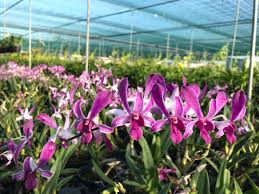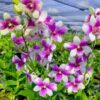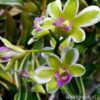# The Influence of Climate on the Flowering of Dendrobium Orchids

Dendrobium orchids, one of the largest genera in the Orchidaceae family, are celebrated for their diverse range of species and stunning floral displays. Found primarily in tropical and subtropical regions, these orchids exhibit unique flowering behaviors influenced by various climatic factors. Understanding how climate affects the flowering of Dendrobium orchids is crucial for horticulturists, conservationists, and orchid enthusiasts. This article will explore the different climatic elements that impact the flowering of Dendrobium orchids, their adaptive strategies, and the implications for cultivation and conservation.
## 1. Overview of Dendrobium Orchids
### 1.1 Taxonomy and Diversity
The Dendrobium genus comprises around 1,800 species, making it one of the most diverse groups of orchids. They can be found in a range of habitats, from rainforests to mountainous regions. Dendrobiums are characterized by their distinctive pseudobulbs and colorful flowers, which vary significantly in size, shape, and color across species.
### 1.2 Flowering Characteristics
Dendrobium orchids typically bloom once a year, although the timing and duration of flowering can vary widely between species. The flowers can last from several weeks to several months, depending on environmental conditions and care. The flowering period is crucial for plant reproduction, as it attracts pollinators, facilitates seed production, and allows for genetic diversity within the population.
## 2. Key Climatic Factors Affecting Flowering
### 2.1 Temperature
Temperature is a critical factor influencing the flowering of Dendrobium orchids. Most Dendrobium species thrive in temperatures ranging from 65°F to 85°F (18°C to 29°C).
– **Day/Night Temperature Variations**: The diurnal temperature range plays a significant role in flower initiation. Many Dendrobium species require cooler night temperatures to trigger flowering. For example, a drop in temperature at night can signal the plant to prepare for the flowering process. Growers often use this principle by reducing nighttime temperatures during the flowering season to encourage blooms.
– **Seasonal Temperature Changes**: In their natural habitats, seasonal temperature changes are a cue for flowering. For instance, a drop in temperature during the dry season can signal Dendrobiums to start blooming, as they anticipate the arrival of the rainy season for successful pollination and seed dispersal.
### 2.2 Light Intensity
Light is another essential factor for the flowering of Dendrobium orchids. These orchids prefer bright, indirect light, mimicking the filtered sunlight they receive in their natural habitats.
– **Light Duration**: The duration of light exposure also affects flowering. Many Dendrobium species require a specific photoperiod (the length of day versus night) to initiate blooms. Increasing light exposure during the growing season can promote healthy growth and enhance flowering potential.
– **Light Quality**: The quality of light, particularly the spectrum of light received, influences flowering. Red and blue wavelengths are crucial for photosynthesis and flower development. Growers should consider using grow lights that provide a full spectrum, particularly during winter months when natural light may be limited.
### 2.3 Humidity
Humidity levels significantly affect the growth and flowering of Dendrobium orchids. These plants thrive in environments with humidity levels between 50% and 70%.
– **Optimal Humidity Conditions**: High humidity supports healthy growth and promotes flowering. When humidity levels are inadequate, plants may become stressed, leading to poor growth and reduced flowering.
– **Humidity Fluctuations**: In their natural habitats, Dendrobiums experience fluctuations in humidity throughout the year, which can stimulate flowering. Growers can simulate these conditions by using humidifiers or placing trays of water near the plants to increase humidity levels.
### 2.4 Watering Regimes
Watering practices are closely linked to climate and can directly influence the flowering of Dendrobium orchids.
– **Watering Frequency**: Dendrobiums require regular watering during their active growth period, typically in the spring and summer. However, they benefit from a period of reduced watering before flowering to trigger the blooming process.
– **Water Quality**: The quality of water used for irrigation can also affect flowering. Using distilled or rainwater is recommended to avoid mineral buildup, which can harm the plant. Proper drainage is essential to prevent root rot, which can inhibit flowering.
### 2.5 Nutrient Availability
Nutrient availability is crucial for the growth and flowering of Dendrobium orchids. The nutrient composition in the growing medium can affect flowering potential.
– **Fertilization Practices**: A balanced fertilizer with higher phosphorus levels is often recommended to promote blooming. Fertilizing every two to four weeks during the growing season can provide the necessary nutrients for healthy growth and flowering.
– **Nutrient Deficiencies**: Insufficient nutrients can lead to poor flower development. Growers should monitor their plants for signs of nutrient deficiencies, such as yellowing leaves or stunted growth, and adjust their fertilization practices accordingly.
## 3. Adaptive Strategies of Dendrobium Orchids
Dendrobium orchids have developed several adaptive strategies to cope with the climatic conditions in their natural habitats, which in turn influence their flowering patterns.
### 3.1 Seasonal Growth Patterns
Dendrobiums exhibit seasonal growth patterns that align with climatic changes. Many species have a distinct dormant period during the cooler months, where they conserve energy and resources. This dormancy is crucial for the initiation of flowering, as it allows the plant to prepare for the upcoming growing season.
### 3.2 Epiphytic Lifestyle
Many Dendrobium species are epiphytes, meaning they grow on other plants without deriving nutrients from them. This lifestyle allows them to access light and moisture more effectively in dense forests. The ability to adapt to different hosts and microhabitats enables them to optimize their growth and flowering under varying climatic conditions.
### 3.3 Genetic Variation
Genetic diversity within the Dendrobium genus allows for a range of adaptations to different climates. Some species are more tolerant of extreme conditions, such as high temperatures or low humidity, while others are adapted to specific microclimates. This genetic variation is essential for the survival and flowering of Dendrobium orchids in changing climates.
## 4. Implications for Cultivation
Understanding the influence of climate on Dendrobium flowering has significant implications for cultivation practices. Growers can optimize their care strategies to promote healthy growth and abundant blooms.
### 4.1 Controlled Environment Cultivation
For those growing Dendrobium orchids indoors or in greenhouses, creating a controlled environment can help mitigate the effects of unfavorable climatic conditions. Utilizing grow lights, humidifiers, and temperature controls can ensure that the orchids receive optimal conditions for flowering.
### 4.2 Seasonal Care Adjustments
Growers should adjust their care practices according to the seasonal changes in climate. This includes modifying watering schedules, light exposure, and fertilization practices to align with the plant’s growth cycle. Recognizing the signs of dormancy and growth can help growers provide the right conditions for successful flowering.
### 4.3 Experimentation with Species
Given the diversity within the Dendrobium genus, growers can experiment with different species to find those that best suit their local climate. Some species may be more adaptable to specific environmental conditions, making them easier to cultivate successfully.
## 5. Conservation Considerations
As climate change continues to impact global weather patterns, the flowering and survival of Dendrobium orchids may be threatened. Conservation efforts are essential to protect these beautiful plants and their habitats.
### 5.1 Habitat Preservation
Preserving natural habitats is crucial for the survival of Dendrobium orchids in the wild. Deforestation, climate change, and urbanization pose significant threats to their natural environments. Supporting conservation initiatives that protect these habitats can help ensure the continued survival of Dendrobium species.
### 5.2 Cultivation and Education
Promoting the cultivation of Dendrobium orchids among hobbyists and enthusiasts can foster appreciation for these plants and their ecological roles. Educational programs can raise awareness of the importance of preserving orchid habitats and the challenges they face in a changing climate.
### 5.3 Research and Monitoring
Ongoing research into the effects of climate change on Dendrobium orchids is vital for understanding how to best protect and conserve these species. Monitoring populations and their responses to changing climatic conditions can provide valuable insights for conservation strategies.
## 6. Conclusion
The influence of climate on the flowering of Dendrobium orchids is a complex interplay of temperature, light, humidity, watering, and nutrient availability. Understanding these climatic factors is essential for successful cultivation and conservation of these stunning plants. As climate change poses new challenges to their survival, it is crucial to adopt adaptive strategies and conservation practices that protect their natural habitats and promote sustainable cultivation. By fostering a deeper appreciation for Dendrobium orchids and their unique adaptations, we can ensure their beauty and diversity endure for future generations.

